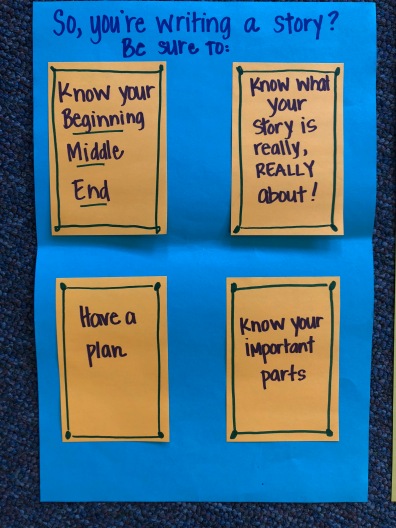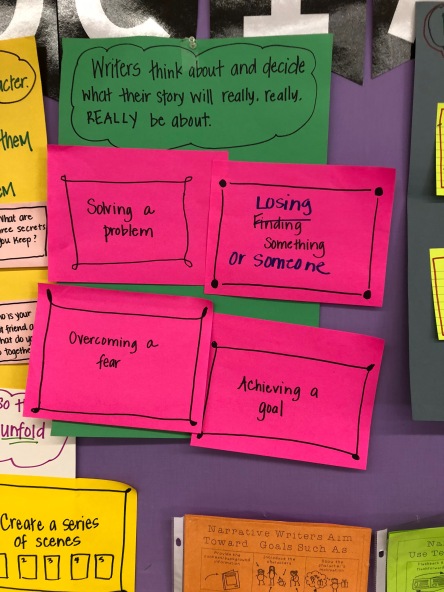Whenever I am working in classrooms, the students who don’t believe in themselves as writers pull me to them like magnets pull iron filings.
“What are you working on,” I ask.
And they struggle to answer. They try. They really do. But if their ability to explain their process is any indication of their understanding of the process, then there’s some work to be done.
Working in an upper elementary classroom throughout a narrative writing unit, I have a few questions that guide my work:
- Where do students get stuck in the process?
- What functioning level are students really on, and how can I nudge them without overwhelming them?
- How can I build a positive relationship between students– especially ones who are facing some obstacles– and writing?
That being said, I also lean on a list of steps that narrative writing involves. While I think this list of steps over-simplifies the complicated business of story-writing, I also think it provides a way for us to begin a conversation with students about where they feel stuck in the process:

When I show this series of steps to students, they are usually able to identify where the work becomes tricky for them, especially if I present this chart with the expectation that we all have places in the process where the work is especially hard. Once students can identify that place, we have some options of how to move their work forward. We can try:
- Some targeted practice at the place where students feel stuck, or;
- Starting from a point farther along in the process
Either one has been effective, and usually the better decision is the one that’s made in collaboration with the student. I usually say something like: “We could either work really hard on that place where you get stuck, or we could bypass it so that you can join in the process, practice farther along, and then eventually return to the place where you were stuck with more confidence as a writer. Which plan of action do you want to take?”
Regardless of the decision, this chart has been really helpful for all students as they get ready to draft, especially the ones who are encountering obstacles:

I share this chart along with the one that gives options for what stories are almost always really really about.

Once students can say their beginning, middle, and end, know what their story is really about, and can identify their important parts, they almost always can make a solid plan and feel comfortable beginning to draft.
A follow up post to this one will be coming, as the next part of our work involves getting students to develop their stories. Tune in on April 22! In the meantime, my goal is to be less of a magnet for those writers who are facing challenges and more of a resource for inspiring independence and confidence.


I have two fourth graders that I plan on using this language, these charts with. I have to merge them with a menu already in use – which I think, just might lead towards a bit more independence and each child beginning to see they do have a story to tell and they CAN tell it! Thank you, Melanie! Timely post for me!
LikeLiked by 2 people
Not only do I love your charts, but I love the way the kids in your schools understand how to utilize the charts and tools independently!
LikeLiked by 1 person
Love your charts and your talk about what a story is really really about. But this . . .”In the meantime, my goal is to be less of a magnet for those writers who are facing challenges and more of a resource for inspiring independence and confidence.” Good LUCK! You exude helpfulness so your magnet super power will probably continue!
LikeLiked by 1 person